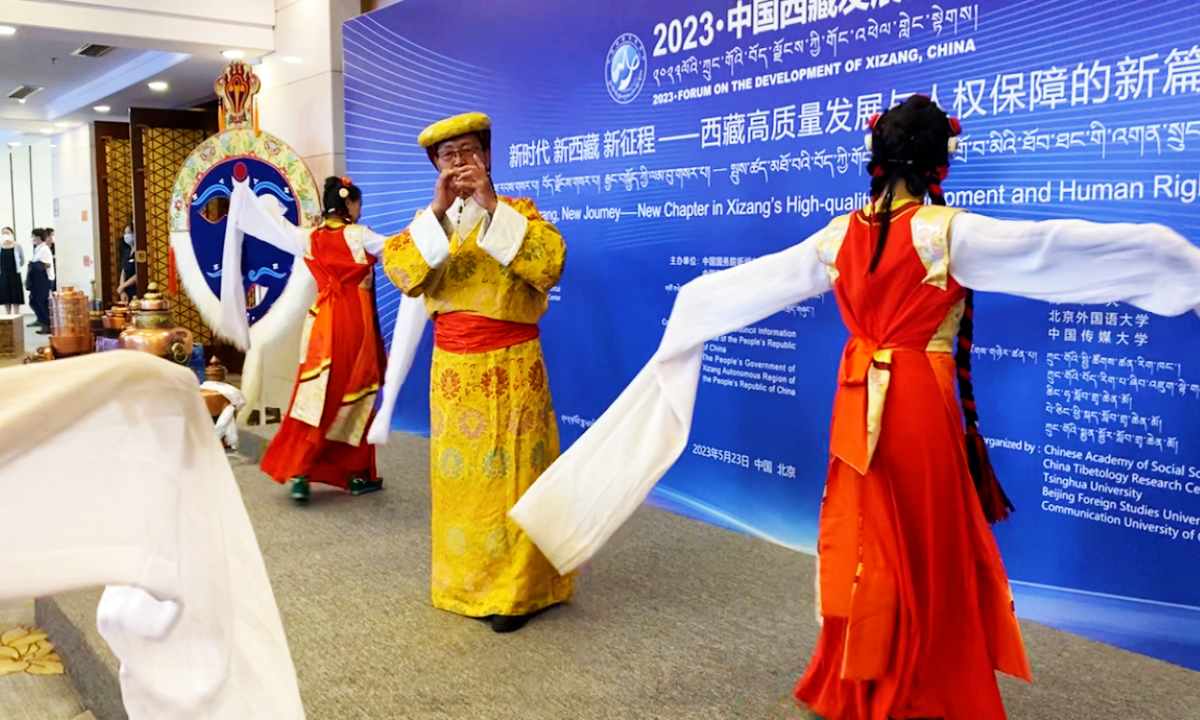
Tseten plays the Tibetan eagle flute during the 2023 Forum on the Development of Xizang in Beijing. Photo: Shan Jie/GT
The melodious sound of the flute resonated throughout the entire venue, captivating both domestic and foreign attendees, who stop and admire it.
On Tuesday, outside the main venue of 2023 Forum on the Development of Xizang in Beijing, artist Tseten and his Tibetan eagle flute transported people thousands of kilometers away to the snowy plateau, as if embarking on a journey on the wings of a majestic eagle.
The Tibetan eagle flute, boasting a history of over 1700 years, derives its name from being crafted from the wing bones of eagles. It is predominantly popular in the Tibetan regions of Xizang Autonomous Region, Sichuan Province in Southwest China, and Gansu Province and Qinghai Province in Northwest China.
Due to the special geographical environment and climate in the Tibetan region, it is extremely difficult to find eagle wing bones, which are the raw materials from which the special flutes are crafted, Tseten, a 70-year-old veteran flute artist from Tibetan Song and Dance Troupe told the Global Times.
According to Tibetan folklore, the eagle will fly straight into the sun at the final moments of its life until it is reduced to ash, so it is difficult to see its bones on the ground. Occasionally, due to extreme weather, eagles do not fly over the snow-capped mountains and are instead frozen to death. Thus people have a rare chance to collect the eagle wing bones.
"However, nowadays wild eagles in Xizang are protected animals, making the instruments more precious," he said.
Actually, for a time, Tibetan eagle flute was almost lost.
Tseten, who started to perform the bamboo flute from a young age, heard about the eagle flute as a child, but had never seen one. But in 1992, he first saw a herdsman's eagle flute in the pastoral area of Qinghai.
"I feel that as a Tibetan performer, I have a responsibility to carry forward and pass on this traditional musical instrument," he said.
After that, in 1996, with the help of Ning Baosheng, then chief flute player of the China National Traditional Orchestra, Tseten made "the first eagle flute for professional performance."
On the Pamir Plateau in the far west part of the Xinjiang Uygur Autonomous Region in Northwest China, the Tajik people also play the eagle flute. But the Tajik eagle flute is more traditional, with only three holes, and it is blown obliquely, while the Tibetan eagle flute has six holes, which is more like a modern musical instrument, and can be played at two octaves with one more tone, which can be used to play more complex tunes, Tseten explained.
Now, this eagle flute has accompanied Tseten in his numerous performances all across China and several overseas countries, representing the sound from the plateau.
To his relief, the protection of traditional musical instruments by the country and the Xizang Autonomous Region is complete, and the Tibetan eagle flute has also been adopted by younger musicians.




